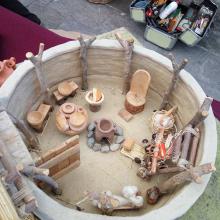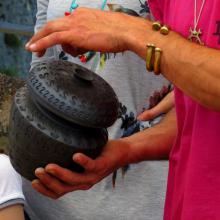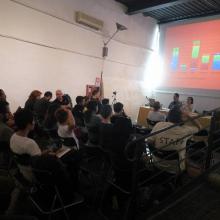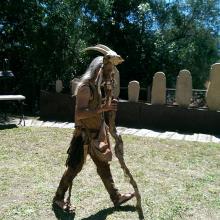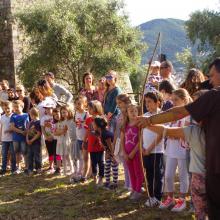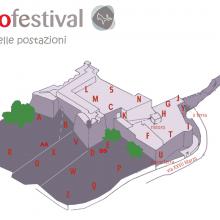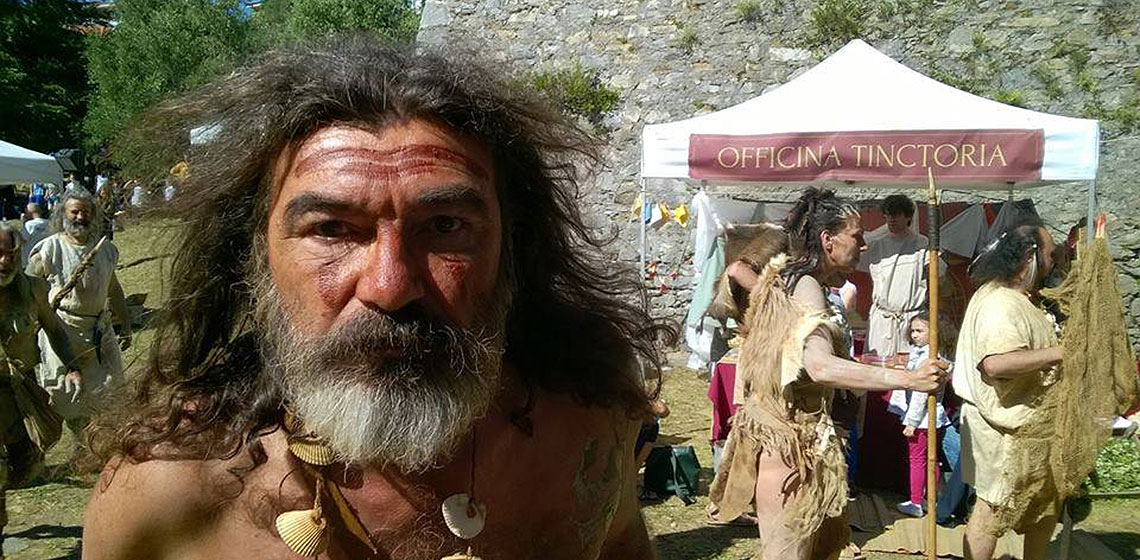
Paleofestival (May 26-27 in La Spezia, Italy) is a weekend of meeting and working with archaeology & the public. EXARC takes part – not just as visitors, but also with workshops and papers. Please register by emailing the EXARC Secretariat. With about 40 different activities, it attracts about 1,500 visitors. The festival shows both prehistory and history and is not limited to Europe. La Spezia is a naval station with a good climate, close to the famous Cinque Terre villages. For more information about the Paleofestival, please check this article in the EXARC Journal: “Paleofestival: 10 years of spreading archaeology in evolution”.
At the 13th Paleofestival you will see the following:
- Archaeological open-air museums doing educational activities
- Archaeotechnicians demonstrating to the public
- Individual professional operators doing educational workshops
- Re-enactors bringing the past to life
Location: Museo del Castello di San Giorgio, Via XXVII Marzo, La Spezia, Italy

Travel & Accommodation
Fly to Pisa (preferred) or Genua.
In Pisa, take the bus to the station and then the train to La Spezia (1 hour) Read more
In Genua, take the bus to the station and then the train to La Spezia (1.5 hours) Read more
Please find yourself a B&B in La Spezia. These are not too expensive.

Registration
Please contact us at r.p.paardekooper@exarc.net if you like to join us. A registration fee of 10 EUR (please pay cash on arrival to EXARC) is required for EXARC members. Further, you need to pay by yourself:
- Travel
- Accommodation
- Food & drinks

Friday, May 25th
| All Day | Arrival |
| 21:00h | joint Dinner (at own expense: 20 EUR per person). We meet at 21:00h sharp in front of the Museo Lia in Via del Prione 234, la Spezia. |
Saturday, May 26th
| 9:00h | visit to Portovenere. We meet at 9:00h sharp in front of the Museo Lia in Via del Prione 234, la Spezia. Registration compulsory |
| 14:00h | Annual General Meeting EXARC (at the Castello San Giorgio) |
| 15:30-20:30h |
There will be close to 36 workshops and demonstrations in different areas around the castle of St. George. These include making fire, the skin of the Universe. Symbols and molds from the Neolithic to pre-Columbian civilizations, pottery, beating and embossing of bronze, casting a bronze sword, a workshop to reproduce fossil footprints, the bow: origins, construction techniques and practical shooting tests, Senet, the game for immortality, the journey of the soul to reach the kingdom of Osiris, hieroglyphic writing lessons on papyrus for adults, a paleontological excavation, the aromas to eat, the history of perfumes enters the kitchen, weaving and spinning, archaic Etruscan writing on a tablet, reproductions of megalithic and Neolithic architecture to scale, hygiene and beauty in ancient Egypt, a sound journey (and not only) from the Upper Paleolithic to the Copper Age, a game from the Roman era, treasures from the sea, making necklaces using shells, mussels and leaves, workshop of processing animal bones for the production of needles and awls, signs on the skin: communicating with the body: henna tattoos inspired by those found on the mummies of antiquity and a free dialogue between a journalist and the Neanderthal man. |
Sunday, May 27th
| 9:00-13:00h |
Paleofestival Conference with lectures & posters Introduction to EXARC The Prehistoric Village of the Valle Del Menago Park in Bovolone (Vr). From the Late Neolithic to the Bronze Age between Reconstruction, Valorization, Experimentation and Didactics Craft of the period of Roman influence in a contemporary artisan's eye. Reconstruction of an artefact or just a visual imitation? Didactics in Archaeology: the experience of Parco Archeologico del Livelet Hide Processing in Prehistory, an experimental approach to prehistoric tanning technologies Archaeology and Didactics for the P. Graziosi Museum, Florence Research perspectives and public reactions from experiments in the combined use of 3D prints and traditional crafted replicas The “L. Fantini” Archaeological Museum of Monterenzio & Monte Bibele Archaeological and Naturalistic Area Experimental Archaeology and Research in European Archaeological Open-Air Museums: research questions The use of the games to avoid the traps of stereotypes, based on the book "Piccole storie" Teaching history with objects, based on the book "Un museo ... 1000 scoperte" |
| 14:30-15:30h | Barter: exchange of raw materials and objects |
| 15:30-19:00h |
There will be close to 36 workshops and demonstrations in different areas around the castle of St. George. These include making fire, the skin of the Universe. Symbols and molds from the Neolithic to pre-Columbian civilizations, pottery, beating and embossing of bronze, casting a bronze sword, a workshop to reproduce fossil footprints, the bow: origins, construction techniques and practical shooting tests, Senet, the game for immortality, the journey of the soul to reach the kingdom of Osiris, hieroglyphic writing lessons on papyrus for adults, a paleontological excavation, the aromas to eat, the history of perfumes enters the kitchen, weaving and spinning, archaic Etruscan writing on a tablet, reproductions of megalithic and Neolithic architecture to scale, hygiene and beauty in ancient Egypt, a sound journey (and not only) from the Upper Paleolithic to the Copper Age, a game from the Roman era, treasures from the sea, making necklaces using shells, mussels and leaves, workshop of processing animal bones for the production of needles and awls, signs on the skin: communicating with the body: henna tattoos inspired by those found on the mummies of antiquity and a free dialogue between a journalist and the Neanderthal man. |

Abstracts
Papers
Introduction to EXARC
Roeland Paardekooper, EXARC (NL)
EXARC is a very wide and open network with over 300 members in 40 countries. We have four themes: archaeological open-air museums, experimental archaeology, ancient technology and live interpretation. Half of our members are museums and universities, the other half are professionals working with our themes. Volunteers carry out most of the work in EXARC. We are especially proud of our website and our EXARC Journal published both online and on paper. We are strong on social media and organize / help with organizing of events and conferences. EXARC offers an international and open network of resources and people as well as the science and expertise behind our work. If you appreciate both near neighbours as well as good friends, you should join EXARC!
Introduzione ad EXARC
Roeland Paardekooper, EXARC (NL)
EXARC è una vastissima e pubblica rete con oltre 300 membri da 40 paesi. Abbiamo quattro aree di interesse: i musei archeologici all’aperto, l’archeologia sperimentale, la tecnologia antica e l’interpretazione dal vivo della storia. Circa la metà dei nostri membri sono musei e università, mentre l’altra metà sono professionisti che lavorano nelle nostre stesse aree di interesse. La maggior parte del lavoro in EXARC è svolto da volontari. Siamo particolarmente orgogliosi del nostro sito web e del nostro “EXARC Journal” pubblicato sia on-line che cartaceo. I social media sono un nostro punto di forza e organizziamo, o aiutiamo nell’organizzazione di eventi e conferenze. EXARC offre una rete internazionale di risorse e persone aperta a tutti, così come la conoscenza e la competenza che sta dietro al nostro lavoro. Se apprezzate i buoni vicini così come i buoni amici, dovreste proprio unirvi ad EXARC!

The Prehistoric Village of the Valle Del Menago Park in Bovolone (Vr). From the Late Neolithic to the Bronze Age between Reconstruction, Valorization, Experimentation and Didactics
Federico Bonfanti & Pedron Simone, Tramedistoria (IT)
The Veronese plain, formed during the final phase of the last glaciation (15,000-10,000 BP) thanks to the huge amount of detritus transported by the Adige river due to the melting of the ice, was inhabited by man starting from the Ancient Neolithic (half VI millennium BC), from people attributable to the culture of Fiorano. In Bovolone the first evidence of human attendance, found in Pila Culà, date back to the Late Neolithic (half of the fourth millennium BC), and are due to the last phase of the Culture of the Vasi a Bocca Quadrata, with the pottery characterized from the particular decoration with incisions and impressions. However, during the Bronze Age (II millennium BC) the territory of Bovolone saw the birth and development of numerous settlements, all located along the paleo-river of the Menago river, evidence of the massive colonization of the people of palafitticolo-terramaricola culture: in this period, in fact, we find the settlements of Novarina, Gesiole, Crosare and Saccavezza, dating between the end of the ancient Bronze Age and the recent Bronze Age (XVIII-XII century BC). A part of the site of Saccavezza is located in the Valle del Menago Park, a large public park of about 35 hectares established in 1995 by the municipality of Bovolone to preserve one of the last lowland wetlands of great naturalistic importance. Inside the Park, to enhance the archaeological component of the place, on a small island surrounded by water, a prehistoric village was rebuilt, managed by the Tramedistoria Association since 2016. It has begun a demanding work of demolition of the old crumbling structures and philological reconstruction of new huts, based on the excavation data of the protohistoric settlements of the Verona plain. The interiors of the huts, two of which are already completed while a third one is under construction, have been furnished with furnishings and artifacts that represent faithful copies of original finds now exhibited mainly at the Centro Ambientale Archeologico Museo Civico di Legnago (VR). In addition to the huts, craft areas were set up for the casting of bronze and the firing of ceramic materials, periodically used according to pre-protohistoric techniques for demonstrations to the public and to school groups. The goal is to make the prehistoric village of Bovolone become a point of reference for the valorization of the archaeological heritage of the Verona plain and for activities of imitative and experimental archaeology, able to attract more schools and visitors. te both near neighbours as well as good friends, you should join EXARC!
Il Villaggio Preistorico Del Parco Valle Del Menago - Bovolone (Vr). Dal Neolitico Avanzato All'eta' Del Bronzo Tra Ricostruzione, Valorizzazione, Sperimentazione E Didattica
Federico Bonfanti & Pedron Simone, Tramedistoria (IT)
La pianura veronese, formatasi durante la fase finale dell’ultima glaciazione (15.000-10.000 BP) grazie all’imponente quantità di detriti trasportati dal fiume Adige in seguito allo scioglimento dei ghiacci, venne abitata dall’uomo a partire dal Neolitico Antico (metà VI millennio a.C.), da genti attribuibili alla cultura di Fiorano. Per quanto riguarda Bovolone, le prime testimonianze di frequentazione umana, rinvenute in località Pila Culà, risalgono al Neolitico Recente (metà del IV millennio a.C. circa), e sono riconducibili all’ultima fase della Cultura dei Vasi a Bocca Quadrata, con la ceramica caratterizzata dalla particolare decorazione ad incisioni ed impressioni. È però durante l’Età del bronzo (II millennio a.C.) che il territorio di Bovolone vede nascere e svilupparsi numerosissimi insediamenti, tutti collocati lungo il paleoalveo del fiume Menago, prova dell’ormai massiccia colonizzazione operata delle genti di cultura palafitticolo-terramaricola: risalgono a questo periodo infatti gli abitati di Novarina, Gesiole, Crosare e Saccavezza, databili tra la fine dell'antica Età del bronzo e il Bronzo recente (XVIII-XII secolo a.C.). Il sito di Saccavezza si trova in parte all’interno del Parco Valle del Menago, un vasto parco pubblico di circa 35 ettari istituito nel 1995 dal comune di Bovolone per preservare uno degli ultimi habitat umidi planiziali, di grande importanza naturalistica. All'interno del Parco, per valorizzare anche la componente archeologica del luogo, su un isolotto artificiale circondato dall'acqua è stato ricostruito un villaggio preistorico, gestito dal 2016 dall'Associazione Tramedistoria. Essa ha iniziato un impegnativo lavoro di abbattimento delle vecchie strutture ormai fatiscenti e di ricostruzione filologica di nuove capanne, basandosi sui dati di scavo degli abitati protostorici della pianura veronese. Gli interni delle capanne, due delle quali già completate mentre una terza è in fase di realizzazione, sono stati arredati con suppellettili e manufatti che rappresentano copie fedeli di reperti originali oggi esposti principalmente presso il Centro Ambientale Archeologico Museo Civico di Legnago (VR). Oltre alle capanne sono state approntate delle aree artigianali per la fusione del bronzo e la cottura dei materiali ceramici, periodicamente utilizzate secondo le tecniche pre-protostoriche per dimostrazioni al pubblico e alle scolaresche. L'obiettivo è far diventare nei prossimi anni il villaggio preistorico di Bovolone un punto di riferimento per la valorizzazione del cospicuo patrimonio archeologico della pianura veronese e per attività di archeologia imitativa e sperimentale, in grado di attirare sempre più scuole e visitatori.

Craft of the period of Roman influence in a contemporary artisan's eye. Reconstruction of an artefact or just a visual imitation?
Katarzyna Badowska, Wojciech Rutkowski & Marcel Bartczak, Instytut Archeologii Uniwersytetu Łódzkiego (PL)
We would like to present results of our ethnographic survey, the subject of which was experimental archaeology. We have asked a group of polish artisans who deal with a reconstruction, a set of questions about the difficulties they encounter during their reproductive work. What is the biggest problem? Where do the artisans derive information about the ancient technology from? How are their products received by recipients? These are just some of the questions that respondents were asked. The chronology of the reconstruction was narrowed down to one historical period (the time of the Przeworsk culture, that is the Pre-Roman and the Roman period on the territory of present-day Poland). It clearly shows the connections between a small group of artisans dealing with ancient methods and the scientific world, the acquisition of historical and archaeological knowledge and ethnographic inspiration in order to solve the problems of craft techniques. Our research includes people involved in various crafts, from metalworking to pottery, which allows us to look at the issue from a broader perspective.
L’artigianato polacco nel periodo di influenza Romana gli occhi di un artigiano moderno. Ricostruzione di un artefatto o solo un'imitazione visiva?
Katarzyna Badowska, Wojciech Rutkowski & Marcel Bartczak, Instytut Archeologii Uniwersytetu Łódzkiego (PL)
Vorremmo presentare i risultati del nostro sondaggio etnografico, il cui tema era l'archeologia sperimentale. Abbiamo chiesto a un gruppo di artigiani polacchi che si occupano di una ricostruzione, una serie di domande sulle difficoltà che incontrano durante il loro lavoro riproduttivo. Qual è il problema più grande? Da dove gli artigiani ricavano informazioni sulla tecnologia antica? Come vengono ricevuti i loro prodotti dai destinatari? Queste sono solo alcune delle domande che gli intervistatori hanno posto. La cronologia della ricostruzione è ristretta ad un periodo storico (il tempo della cultura di Przeworsk, cioè il periodo preromano e romano sul territorio dell'attuale Polonia). Si evidenziano così le connessioni tra il gruppo degli artigiani che si occupano di metodi antichi e il mondo scientifico con l'acquisizione di conoscenze storiche e archeologiche e l'ispirazione etnografica per risolvere i problemi delle tecniche artigianali. La nostra ricerca include persone coinvolte in vari mestieri, dalla lavorazione dei metalli alla ceramica, e ciò ci consente di esaminare la questione da una prospettiva più ampia.

Didactics in Archaeology: the experience of Parco Archeologico del Livelet
Maura Stefani, Marta Modolo, Fabio Sartori, Parco Archeologico del Livelet (IT)
Parco Archeologico didattico del Livelet was born from the desire to give value to the archaeological site of Colmaggiore di Tarzo and to promote the history and the environment of the area. The Open-Air Museum is owned by the Province of Treviso and managed by Comitato Provinciale UNPLI Treviso, in convention with the municipality. It is located on the western shore of Lago lake, in the north of Treviso Province, Veneto Region (Italy) and it has been an EXARC member since 2009. The Archaeological open-air museum is based on the reconstruction of three pile-dwellings in full-scale, built using methods and materials available in prehistory, furnished with reconstructions of instruments used in everyday life. Each building is dedicated to a prehistoric period when the area of the lakes was settled, according to the archaeological remains: Neolithic, Copper Age and Bronze Age. Livelet offers guided tours and workshops connected to Archaeology, Prehistory and Nature. During the week, from February to November, it is open for school groups; on Sunday or during special events, from April to October, it is open to the public. It is possible to book thematic guided tours and other activities for groups. In 10 years of activities, Livelet organized special events and activities for the visitors cooperating with professionals from other museums or from other structures. Some of them become habitual and part of the permanent offer, like the naturalistic activities (guided tours around the lakes, workshops, brochures, maps and leaflets for schools), whereas some of the others change every year and give our staff the opportunity to meet professionals from other realities, to exchange knowledge and good practices and to offer our returning visitors new experiences (staff exchanges, special opening dedicated to different historic periods, living history festivals). Based on this experience it is possible to affirm that in an open air museum the didactic contents are not strictly connected to the permanent structures built in it, but are made by the people who work there, permanently or occasionally, and who bring their experiences and knowledge, renovating the cultural offer and creating places for culture at 360°.
Didattica e divulgazione al Parco Archeologico del Livelet
Maura Stefani, Marta Modolo, Fabio Sartori, Parco Archeologico del Livelet (IT)
Il Parco Archeologico didattico del Livelet nasce dalla volontà di valorizzare il sito archeologico di Colmaggiore di Tarzo e di promuovere la storia e l'ambiente della territorio in cui sorge. Il Parco è di proprietà della Provincia di Treviso e dal 2009 è gestito dal Comitato Provinciale UNPLI Treviso, in convenzione con il Comune di Revine Lago. La struttura si trova sulla sponda occidentale del lago Lago, a Nord della Provincia di Treviso, in Veneto, ed è membro EXARC dal 2009. Al Livelet sono presenti le ricostruzioni di tre palafitte in scala reale, costruite con metodi e materiali utilizzati anche in passato e arredate con la ricostruzione di strumenti utilizzati durante la vita di tutti i giorni. Ogni edificio è dedicato a un periodo preistorico in cui, secondo i dati archeologici, fu insediata l'area dei laghi: Neolitico, Età del Rame e Età del Bronzo. Il Livelet offre ai visitatori visite guidate e laboratori a tema archeologico, preistorico e naturalistico. Durante la settimana, da Febbraio a Novembre, è aperto su prenotazione per le scolaresche, mentre di Domenica e nei giorni festivi, da Aprile a Ottobre, è aperto al pubblico. È possibile prenotare visite guidate a tema e altre attività per gruppi e non mancano aperture speciali o serali in estate. In 10 anni di apertura, al Livelet sono stati organizzati numerosi eventi per i visitatori in collaborazione con professionisti provenienti altri musei o da altre strutture. Alcuni di essi sono diventati abituali e sono entrati a far parte dell'offerta permanente, come le attività naturalistiche (visite guidate intorno ai laghi, laboratori, brochure, mappe e dépliant per le scuole), mentre altri cambiano di anno in anno e danno agli operatori l'opportunità di incontrarsi professionisti di altre realtà, per scambiare conoscenze e buone pratiche, e offrire ai visitatori esperienze sempre nuove (scambi di personale, eventi speciali dedicati a diversi periodi storici, festival di rievocazione). Sulla base di questa esperienza, è possibile affermare che in un parco archeologico i contenuti didattici non sono strettamente collegati alle strutture permanenti, ma sono forniti in primis dalle persone che ci lavorano, abitualmente o occasionalmente, che portano le loro esperienze e conoscenze, rinnovando continuamente l'offerta e rendendoli luoghi di cultura a 360°.

Hide Processing in Prehistory, an experimental approach to prehistoric tanning technologies
Theresa Emmerich Kamper, University of Exeter (UK)
The importance of skin processing technologies, in the history and dispersal of humankind around the planet cannot be overstated. This presentation outlines a systematic analysis methodology targeted at this specific material type, with the goal of determining the tanning technologies in use during prehistory, from extant archaeologically recovered processed skin objects. The methodology is a product of macroscopic and microscopic observations of a sample reference collection containing over 200 samples. Which were used to produce a database of defining characteristics and tendencies for each of six tannage types; wet and dry scrape brain tan, bark tan, alum taw, urine tan and rawhide. The sample collection is made up of twenty-two economically important species from both Europe and North America, as well as a collection of well-used clothing and utilitarian items, made from traditionally processed skins. This research has demonstrated that archaeologically preserved objects made from processed skin can provide information about the tannage technologies in use prehistorically, as well as more detailed information such as manufacturing sequences and the conditions of use to which the object was subjected.
La lavorazione della pelle. Un approccio sperimentale alle tecnologie di concia preistorica
Theresa Emmerich Kamper, University of Exeter (UK)
L'importanza delle tecnologie di trattamento della pelle, nella storia e nella dispersione del genere umano in tutto il pianeta non può essere sopravvalutata. Questa presentazione delinea una metodologia di analisi sistematica mirata a questo specifico tipo di materiale, con l'obiettivo di determinare le tecnologie di concia in uso durante la preistoria partendo dai reperti archeologici in pelle lavorata. La metodologia è il risultato di osservazioni macroscopiche e microscopiche su di una raccolta di oltre 200 campioni utilizzati poi per produrre un database di definizioni di caratteristiche e tendenze per ciascuno dei sei tipi di concia: umida e secca con l'utilizzo di materia celebrale, mediante corteccia, con allume, con urina e infine pelle grezza. La collezione di campioni è composta da pelli di ventidue specie animali provenienti sia dall'Europa che dal Nord America importanti economicamente, oltre ad una collezione di abiti e oggetti usati fatti con pelli lavorate tradizionalmente. Questa ricerca ha dimostrato che i reperti archeologici in pelle trattata possono fornire informazioni sulle tecnologie di concia in uso preistorico, così come informazioni più dettagliate come sequenze di produzione e le condizioni d'uso a cui l'oggetto è stato sottoposto.

Archaeology and Didactics for the P. Graziosi Museum, Florence
Valter Fattorini, Museo e Istituto Fiorentino di Preistoria “P. Graziosi” & Alessandro Filippi, Università degli Studi di Firenze (IT)
A clear language and a simple approach, together with certain sources from accredited scholars, are the basic prerequistes for our activities in primary schools of Tuscany, during which, through manual activities, studunts live specific moments of the history of civilization. The activities are essentially focused on the manipulation of “non-school” materials, with the purpose of imitating ancient artifacts, always in interconnection with the curricular programs of the involved students. We always find a valid help in showing how important is the study of archaeological evidences, with the support of figurative apparatus, and, when possible, bearing examples of archaeological evidences as close as possible to the audience. Our didactic workshops have an interdisciplinary character, conveying acquisitions and skills not only in history and archaeology but also in history of art, geography, technology and anthropology.
Laboratori di storia e Archeologia per il Museo Fiorentino “P. Graziosi”
Valter Fattorini, Museo e Istituto Fiorentino di Preistoria “P. Graziosi” & Alessandro Filippi, Università degli Studi di Firenze (IT)
Un linguaggio chiaro e semplice unitamente a notizie certe di studiosi accreditati, sono i presupposti per i laboratori didattici nelle scuole primarie, dove con intensa attività manuale gli alunni vivono momenti specifici della storia di una civiltà. I laboratori sono essenzialmente incentrati sulla manipolazione di materiali non scolastici con l'intento di imitare nella ricostruzione alcuni manufatti delle civiltà antiche, in relazione alle programmazioni curriculari delle classi coinvolte. Gli alunni sono coinvolti in prima persona nello studio delle testimonianze archeologiche, con il supporto di apparati figurati inerenti all'argomento e, quando è possibile, partendo dalle testimonianze presenti nel territorio e nelle attività di laboratorio di manipolazione e costruzione di manufatti. Le lezioni hanno un carattere interdisciplinare, convogliando acquisizioni e competenze in ambito non solo storico ma anche artistico, tecnico, geografico e antropologico.

Research perspectives and public reactions from experiments in the combined use of 3D prints and traditional crafted replicas
Professor Linda Hurcombe, University of Exeter (UK)
The Touching the Past project, funded by the AHRC, explored a variety of haptic experiences in museums but 3D prints provided particular benefits for the public and research alike. In most museums, presentations of archaeological artefacts are dominated by displays behind glass; vision dominates the sensory experience. The emotional connections built by more multisensory engagement with artefacts offers a better appreciation of the ancient objects and an enhanced museum visit. Museum presentations benefitted from sensory engagement and direct authenticity in relationships. The latter was achieved by a process termed 'borrowed authenticity'. The solutions and ideas have been tried out in 'touching the past' events at Kirkwall Museum, as part of Orkney Science week and the National Museums Scotland, Edinburgh and also formed part of workshop activities under the EU funded project, OpenArch. These events have sought to generate public interest in the research and been a source of experimental trials to investigate public reactions to replicas. However, they have also provided a means of communicating between craft specialists and researchers, and they have informed the craft specialist at many levels along the way, and provided new information to researchers. In experimental archaeology, the value of reconstructions has long been recognised as both a research act and powerful presentation tool. The crafting of a traditional replica drew on some of the details of the 3D print to assist in making the large and small decisions of any craft process. This led to small details being scrutinised providing new information to visitor and researcher alike. The project has moved from ideas to proof of concept trials and contributed to several three-month exhibitions in the UK and abroad with project objects now being placed in a variety of heritage settings.
Prospettive di ricerca e reazioni pubbliche agli esperimenti nell'uso combinato delle repliche create con le stampanti 3D e le repliche create in modo tradizionale.
Professor Linda Hurcombe, University of Exeter (UK)
Il progetto “Toccando il passato”, finanziato dall'AHRC, esplora una varietà di esperienze tattili ma le stampe in 3D hanno fornito benefici particolari sia per il pubblico che per la ricerca. Nella maggior parte dei musei, le presentazioni dei manufatti archeologici vengono mostrate all'interno di una vetrina; la vista domina l'esperienza sensoriale. Le connessioni emotive create da un'interazione multisensoriale con i manufatti offre un miglior apprezzamento degli oggetti antichi e una migliore visita del museo. Le presentazioni del museo hanno beneficiato dell'impegno sensoriale e dell'autenticità diretta nelle relazioni. Quest'ultima è stata ottenuta da un processo chiamato “autenticità in prestito”. Le soluzioni e le idee sono state collaudate negli eventi di “Toccando il passato” al museo di Kirkwall, come parte della settimana della scienza del Museo Orkney e al Museo Nazionale Scozzese, a Edimburgo, e sono state anche parte delle attività di workshop del progetto finanziato dalla UE chiamato OpenArch. Questi eventi hanno cercato di generare un interesse pubblico nella ricerca e sono stati una fonte di test sperimentali per indagare le reazioni pubbliche alle repliche. Inoltre hanno anche fornito un mezzo di comunicazione fra gli specialisti dell'artigianato e i ricercatori e, durante il percorso, hanno fornito informazioni a più livelli agli artigiani e ai ricercatori. Nell'archeologia sperimentale, il valore delle ricostruzioni è stato riconosciuto da molto tempo sia come atto della ricerca che come potente strumento di presentazione. L'elaborazione di una replica tradizionale ha attinto alcuni dei dettagli della stampa 3D per contribuire a prendere le grandi e piccole decisioni di ogni processo artigianale. Questo ha comportato che i piccoli dettagli siano stati scrutati per fornire nuove informazioni al visitatore e al ricercatore. Il progetto è passato dalle idee alla sperimentazione dei concetti e ha contribuito a numerose mostre temporanee di 3 mesi nel Regno Unito e all'estero con oggetti progettati per questo scopo che sono ora collocati in numerosi contesti culturali.

The “L. Fantini” Archaeological Museum of Monterenzio & Monte Bibele Archaeological and Naturalistic Area
Annachiara Penzo, Museo Civico Archeologico "L. Fantini" (IT)
The association Arc.a Monte Bibele is managing the ‘L. Fantini’ Archaeological Museum of Monterenzio & Monte Bibele Archaeological and Naturalistic Area, on the Apennine hills very close to the Metropolitan city of Bologna (Italy). The new museum exhibition, inaugurated in 2015, is dedicated to the archaeological finds of the Idice and Zena valleys, which describe the local Apennine populations from the Prehistory to the Roman Age. The museum exhibition focuses on the reconstruction of two houses of the Etruscan-Celtic settlement of Monte Bibele (from the 4th to the 2nd centuries BC), one inside and one outside the museum building. The museum halls exhibit also finds from the votive deposits and the necropolises of Monte Bibele and Monterenzio Vecchio, including metal weaponry, ornaments, and banquet and libation sets. A tactile path with panels in Braille writing is also available to allow all visitors to touch reproductions of different objects on display. One of the most exciting finds in the museum is a solar dial, an Etruscan astronomical instrument used for foundation rituals. The walk into the nearby Monte Bibele Archaeological and Naturalistic Area shows many fascinating evidence, including two houses of the ancient village accurately rebuilt in their original location, streets, sacred areas, stonework well. The area is representative of the unique example of an alliance between Celts and Etruscans in their attempt of opposing the Roman advance. Thanks to the POR FESR European funds for Emilia-Romagna, new excavation and restoration activities and a network of visitor paths have provided a fundamental starting point to foster the international recognition, visibility and access to this unique archaeological compound.
Il museo Civico Archeologico “L. Fantini” di Monterenzio e l’area archeologico-naturalistica di Monte Bibele
Annachiara Penzo, Museo Civico Archeologico "L. Fantini" (IT)
L'associazione Arc.a Monte Bibele gestisce il Museo Civico Archeologico “L. Fantini” di Monterenzio e l’Area Archeologico-Naturalistica di Monte Bibele, sulle colline dell'Appennino in prossimità della Città Metropolitana di Bologna (Italia). La nuova esposizione museale, inaugurata nel 2015, è dedicata ai reperti archeologici delle valli dell’Idice e dello Zena, che descrivano le popolazioni appenniniche locali dalla Preistoria all'Età Romana. Il percorso espositivo ruota attorno alla ricostruzione di due case dell'insediamento etrusco-celtico di Monte Bibele (inizi IV – inizi II secolo a.C.), una all'interno e l'altra all'esterno dell'edificio. Le sale raccolgono, inoltre, i materiali provenienti dai depositi votivi e dai corredi funebri delle necropoli di Monte Bibele e Monterenzio Vecchio, con armi in metallo, ornamenti e set per il banchetto e il simposio. È poi presente un percorso tattile con pannelli in scrittura Braille, che consente a tutti i visitatori di toccare riproduzioni fedeli di diversi oggetti. Uno dei reperti più intriganti del museo è sicuramente il quadrante solare, uno strumento astronomico etrusco utilizzato per i rituali di fondazione. La vicina area archeologico-naturalistica di Monte Bibele mostra molte testimonianze affascinanti, tra cui due case dell'antico abitato accuratamente ricostruite nella loro posizione originale, strade, aree sacre e una cisterna in pietra. L'area rappresenta il più importante complesso archeologico italiano, ed uno dei più noti in Europa, per quanto riguarda le alleanze tra Celti, Etruschi, Umbri e Liguri nel loro tentativo di opporsi all'avanzata romana. Grazie ai fondi europei POR FESR per l'Emilia-Romagna, le nuove attività di scavo e restauro e una rete di percorsi per i visitatori hanno fornito un fondamentale punto di partenza per favorire il riconoscimento internazionale, la visibilità e l'accesso a questo straordinario complesso archeologico.

Experimental Archaeology and Research in European Archaeological Open-Air Museums: research questions
Lara Comis (IE)
Archaeological Open-Air Museums are the places of many different activities, starting from the reconstructions of buildings to specific educational activities for the visitors about many aspects of the past. In this paper, the attention is set on experimental archaeology and research activities. A considerable amount of research, or applied research, if not experimental archaeology, is usually needed to build the reconstructions. But also, during smaller, or “ordinary” activities, the amount of information that the public and the museum operators can gather can be very useful to archaeological research. On the other hand, research institutions are leading experiments in archaeology which could be carried out in Archaeological Open-Air Museums or used to perform up to date and intriguing new educational activities. My PhD research at UCD School of Archaeology (Dublin, IE) tries to detect best practices to bridge this gap. To assess the current situation in Europe a questionnaire was designed and will be presented in this occasion.
Archeologia Sperimentale e Ricerca nei Musei Archeologici all'Aperto in Europa: sondaggio esplorativo
Lara Comis (IE)
Nei Musei Archeologici all’Aperto vengono svolte molte attivita’, a partire dalla ricostruzione degli edifici prima dell’apertura sino ad attivita’ educative per il pubblico su molti diversi aspetti del passato. In questo intervento si parlera’ di attivita’ di archeologia sperimentale e di ricerca. Una discreta quantita’ di ricerca, o di ricerca applicata, se non archeologia sperimentale, viene svolta di solito per costruire gli edifici. Tuttavia, anche durante attivita’ piu’ limitate o “ordinarie”, il pubblico e gli operatori museali raccolgono informazioni che potrebbero essere molto utili alla ricerca archeologica. D’altra parte, le istituzioni di ricerca svolgono esperimenti in archeologia che potrebbero anche essere portati avanti in un AOAM, o “tradotti” per realizzare attivita’ educative aggiornate e affascinanti. Il mio dottorato di ricerca presso la University College Dublin (IE) si propone di individuare le best practices per far incontrare queste due realta’. Per valutare la situazione attuale in Europa e’ stato creato un questionario che verra’ presentato in questa occasione.

The use of the games to avoid the traps of stereotypes, based on the book "Piccole storie"
Antonio Brusa, Museo delle Palafitte di Ledro (IT)
Gamification is a word of success, in schools as in the museum. Therefore, it is also time to build a critical apparatus, to evaluate the games that circulate. The examples that are provided in this workshop are intended to solicit the discussion about some characteristics of a "good educational game": the brevity, the simplicity and the ability to make the students discover something important. In the cases that will be presented, these discoveries will concern the questioning of stereotypes and misconceptions about some strategic concepts, to understand prehistory: ecological niche, power, time, evolution. The most curious, will find in Piccole storie (La Meridiana 2013) all the instructions to propose and play them, in the classroom as in a museum.
L’uso dei giochi per evitare le trappole degli stereotipi, basato sul libro “Piccole storie”
Antonio Brusa, Museo delle Palafitte di Ledro (IT)
“Gamification” è la parola del momento, a scuola come al museo. Nonostante ciò, è arrivato il momento di costruire un apparato critico che permetta di valutare i giochi che sono ora in circolazione. Gli esempi forniti in questo workshop intendono stimolare la discussione su alcune caratteristiche di un “buon gioco educativo”: la brevità, la semplicità e l’abilità nel far scoprire agli studenti qualcosa di importante. Nel caso in oggetto, queste scoperte riguarderanno gli interrogativi sugli stereotipi e i malintesi sorti intorno ad alcuni concetti strategici che permettono la comprensione della preistoria: la nicchia ecologica, il potere, il tempo, l’evoluzione. La cosa più curiosa è che tutte le istruzioni per presentare e giocare con questi concetti, a scuola come in museo, si troveranno proprio in “Piccole storie” (La Meridiana, 2013).

Teaching history with objects, based on the book "Un museo ... 1000 scoperte"
Romana Scandolari, Museo delle Palafitte di Ledro (IT)
The teaching of the object is a set of techniques that allow the use of material sources for educational purposes, is to generate knowledge, which is exactly the task of the museum and the school. These two institutions are natural allies in this mission; but far beyond simple education and the generation of new knowledge, what really matters is to teach a method to generate critical thinking in citizens. (Joan Santacana Mestre and Nayra Llonch Molina, 2012, Manual de didáctica del objecto en el museum, Ediciones Trea, S.L.) In the professional life of museum educators, it happens to feel that you are following paths very far away from the beaten tracks. You feel a brave and little reckless pioneer of edutainment ... at least until you cross paths marked by real educational specialists, generous, exciting communicators who instill courage and a little security for what you have been done. What I present today is a part of the path that led me to write the book "A museum ... 1000 discoveries". I use the words of prof. Santacana Mestre to close the ideal circle: starting from the Game used by prof. Brusa to avoid stereotypes it leads, even by means of a simple visit to the museum, to generate critical thinking in who are the future citizens of a complex and globalized society.
La didattica dell’oggetto al museo, basato sul libro “Un museo … 1000 scoperte”
Romana Scandolari, Museo delle Palafitte di Ledro (IT)
La didattica dell’oggetto è un insieme di tecniche che permettono l’uso delle fonti materiali per scopi didattici, cioè per generare conoscenza, che è esattamente il compito del museo e della scuola. Queste due istituzioni sono alleate naturali in questa missione; però molto oltre la semplice istruzione e la generazione di nuove conoscenze, quel che realmente importa è insegnare un metodo per generare il pensiero critico nei cittadini. (Joan Santacana Mestre y Nayra Llonch Molina, 2012, Manual de didáctica del objecto en el museo, Ediciones Trea, S.L.). Nella vita professionale di educatori museali capita di avere la sensazione di seguire dei percorsi molto lontani dai tracciati più battuti. Ci si sente pionieri coraggiosi e un filo impavidi dell’edutainment, almeno fino a quando non si incrociano le Strade segnate da veri specialisti della didattica, comunicatori generosi, appassionati e appassionanti che ci infondono coraggio e un po’ di sicurezza per quanto fatto. Quello che vi presento oggi è un pezzetto del percorso che mi ha portato a scrivere il libro “Un Museo… 1000 scoperte”. Le parole del prof. Santacana Mestre le uso per chiudere il cerchio ideale che, a partire dal Gioco usato dal prof. Brusa per svelare gli stereotipi, porta, anche attraverso una semplice visita in museo, a generare pensiero critico nei futuri cittadini di una società complessa e globalizzata.


